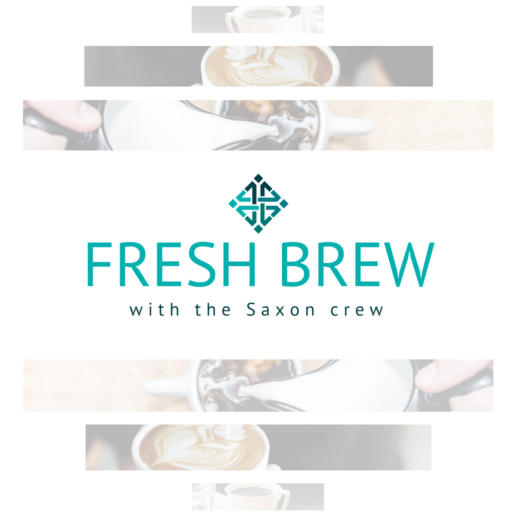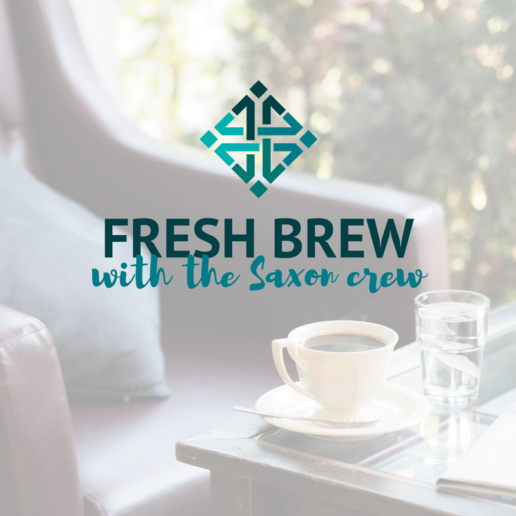Fresh Brew With Matthew Bosse
Welcome to our brand new segment, Fresh Brew, where we will be exploring the delicious coffees, teas, and snacks of some of our employees!
“You will not see satisfactory achievements if no action is taken to get there.”
Matthew Bosse is a Data Analyst at Saxon Financial Services.
Matthew’s journey to becoming a Data Analyst at Saxon began at Sunspot Pool and Patio during his 4-year, academic career. It taught him the importance of professional communication, as well as how to resolve issues for a customer in the best possible way.
In his off time, Matthew spends it with his Mini Goldendoodle named Jameson and with his close family and friends. He also loves to build model cars, go golfing, playing pickup soccer and building fun projects.


Rounding Third
Matthew enjoys sipping on his favorite brew, Rounding Third, while sitting outside at Madtree, relaxing.

Spicy Balls
Matthew enjoys sipping on a Bud Light and snacking on Spicy Balls at Dana Garden.
U.S. employers eye cutting wasteful drugs worth $6 billion
A group of researchers has found that there are medications that could be less expensive alternatives that could be covered by employers based on the benefits provided to employees. Read this blog post to learn more.
A health plan covering thousands of California teachers stopped paying for a diabetes drug that cost $352 per prescription. In its place, the plan now pays less than $13.
The difference? Instead of getting a 1,000-milligram dose of metformin, members got two 500-milligram pills.
It’s just one example of what some employers call “wasteful drugs,” and a coalition of West Coast employers says there are hundreds more. At a time when U.S. President Donald Trump is pushing to trim drug costs for Medicare by tying them to prices in other countries, the coalition is on a crusade to cut company spending on drugs nationwide by simply noting the cheaper choices already available, drawing the ire of drugmakers.
A guidebook produced by the Pacific Business Group on Health and researchers from Johns Hopkins University identifies 49 medications with less expensive alternatives that could be cut from the lists of drugs covered by employers. The group has pushed its approach to large employers for two years. Now it’s focusing on mid-sized companies at conferences, with webinars and through an online Excel sheet designed to help any company identify savings.
Lauren Vela, senior director of member value at the coalition, said it all comes down to who gains in the end. “There are so many folks making so much money on the existing system that the folks who really know how the system works don’t have an interest in changing it,” Vela said by telephone.
Vela presented at three online conferences this summer, and has at least two scheduled for the early fall, she said.
The medications outlined in the guidebook accounted for more than $6 billion in U.S. retail drug spending in 2019, according to data compiled by Bloomberg from Symphony Health. Drugmakers have long been under attack for how they price medications sold in the U.S., and for their efforts to undermine rules on when their products can be sold generically for less.
On Sunday, just weeks before the presidential election, Trump announced he had signed a presidential order on the “most favored nation” plan, which would try to link Medicare Part B and Part D prices to lower prices paid by other countries. In response, groups representing drugmakers said this could hurt their ability to find and test for new medications, while House Speaker Nancy Pelosi said Trump’s action took “no real action” to lower prices.
Researchers aligned with the Pacific Business Group, meanwhile, have analyzed six months of drug use and more than 2.5 million scripts for 15 large self-insured companies. They found that 6% of all claims were for what the report termed “wasteful drugs.”
In the case of just one, the leukemia drug Gleevec, use of generic imatinib could cut the average wholesale price 96%, a savings of $108.28 per pill, according to the report. The group says hundreds of other drugs could be replaced similarly.
“Generic drugs are an important part of the full spectrum of health-care solutions,” said Julie Masow, a spokeswoman for Novartis, the Swiss-based maker of Gleevec.
But the drug, which lost patent protection in the U.S. in 2016, “will remain on the U.S. market to maximize choice for health-care professionals and patients,” Masow said, “and Novartis plans to continue financial support for eligible patients.”
The Pacific Business Group also calls out therapies that combine two existing, cheaper pills into a more expensive single dose. And they urge removing pricey drugs that offer only small changes for the consumer, such as certain extended-release formulations or different dosage concentrations.
Drugmaker pushback
While the Pacific Business Group’s guidebook is gaining support among companies, PBMs — which administer drug plans — and pharmaceutical companies are pushing back.
Drugmakers are taking issue with characterizing drugs as “wasteful.”
“Decision-making power on what medicines patients should take should rest with doctors,” Katie Koziara, a spokeswoman for the Pharmaceutical Research and Manufacturers of America, said in an email.
Koziara said her group favors reforming the rebate system “to help correct PBMs and payers’ misaligned incentives,” boost transparency and share rebates directly with patients.
A trade group for PBMs, meanwhile, disputed the Pacific Business Group’s guidebook, saying it was based on limited data.
Greg Lopes, a spokesman for the Pharmaceutical Care Management Association, called the reports “dated” and said, “PBMs are the only entity in the supply chain reducing drug costs for consumers.”
Pharmacy benefit managers negotiate with drug manufacturers on behalf of employers, determining which drugs should be covered. But the employers say that the way PBMs’ services are sold makes it tough to tell whether they’re really saving money.
PBMs and consultants will typically present a spreadsheet that shows administrative fees, discount off-list prices, and rebate payments. The rebates flow from drugmakers to PBMs and ultimately back to plan sponsors, like employers or unions.
But Vela says employers often can’t easily tell if PBMs retain a portion of the rebates or other payments that incentivize them to keep expensive drugs on the formulary. “You’re hiring an entity to negotiate on your behalf, and the party with whom they’re negotiating is giving them money you don’t know about,” Vela said.
As the PBM business model has come under more scrutiny, benefit managers have pledged to be more transparent with rebates and pass them back to employers.
After recent mergers, the three largest PBMs are now part of companies that also own health insurers, pharmacies and other medical providers: UnitedHealth Group’s OptumRx; CVS Health Caremark; and Cigna Express Scripts.
None of the three leading PBMs would comment on the guidebook analysis.
The array of discounts and rebates PBMs tout to their clients often obscures the fact that employers are paying for high-priced drugs when lower-cost alternatives exist, according to Thomas Cordeiro, a co-author of the guidebook and president of consultant Integrity Pharmaceutical Advisors.
“Just because you have a high rebate doesn’t mean your cost is going to be low,” Cordeiro said.
SOURCE: Bloomberg News. (14 September 2020) "U.S. employers eye cutting wasteful drugs worth $6 billion" (Web Blog Post). Retrieved from https://www.employeebenefitadviser.com/articles/u-s-employers-eye-cutting-wasteful-drugs-worth-6-billion
Strategies for maintaining employee trust during executive turnovers
While being in the midst of the COVID-19 pandemic, it's important to keep employee trust and confidence intact. As there may be turnovers and layoffs happening with executives, it's key to communicate with employees that their employers are listening. Read this blog post to learn more.
As businesses struggle with the obstacles of maintaining a new workplace normal in the midst of the coronavirus crisis, ambiguity and unpredictability can threaten employee trust and confidence.
Sweeping layoffs across all industries are putting more pressure on that delicate relationship between employers and employees. Employers increasingly must reassure employees about their job security and the stability of the company, and how they respond will have long-term ripple effects on loyalty and potential turnover, experts say.
“A CEO’s exit or a round of layoffs can have a detrimental effect on employee retention and well-being if not addressed properly,” says Laura Hamill, chief science officer and chief people officer at Limeade, an employee experience company. “It’s important to show employees as soon as possible that you are listening, that you understand their concerns, and that you are working to address them.”
Just before the virus took root in the U.S., former Walt Disney CEO Bob Iger unexpectedly stepped down at the end of February. Around the same time, Expedia laid off 12% of its global workforce, which came on the heels of Wayfair’s January layoffs. Online travel agency Booking announced in early April that CEO Glenn Fogel has tested positive for coronavirus but still plans to continue with his responsibilities.
These major changes can create a lot of uncertainty within an organization, leaving HR and senior leadership in charge of keeping the business on track and reducing employee turnover.
“CEO shake ups [and layoffs] can create two disharmonies,” says Dania Shaheen, vice president of people operations at Kazoo, an employee experience platform. “There is always a lot of noise created with things like this, gossip about why someone stepped down. This tends to be very distracting from what the business is actually doing.”
The often abrupt departure of a CEO can also lead to a shift in strategy, Shaheen says. While a CEO’s vision for a company can be a rallying cry within the organization when that changes, it can upset the company culture. But there are steps employers can take to get out ahead of this.
In the case of Disney, Iger has remained on board to insure the strategy he has established remains in place. This can help ensure a smoother transition of power.
“The more transparent [a company is] and the more open they are internally about what’s going on is going to be key,” Shaheen says.
Frequent and open communication is another necessity for employers during times of business tumult, Hamill says. By planning for the worst-case scenario and having a clear communication policy, organizations can address employee concerns, collect feedback, gauge sentiments, and implement change quickly. Employers shouldn’t wait until they have all of the answers buttoned up.
“When a major change occurs, organizations need to put employees first,” Hamill says. “Be transparent with employees and offer two-way communication – ensure that people feel supported. This needs to come from all angles — from leaders, managers, and internal teams like human resources.”
An organization’s culture is only as strong as the example being set by its senior leadership. In response to mass layoffs and financial losses, many CEOs and other executives have decided to take pay cuts or forego their salaries. New Disney CEO Bob Chapek will take a 50% pay cut, while Iger — who remains with the company as executive chairman — will forgo his entire salary.
Dick's Sporting Goods announced that CEO Ed Stack and President Lauren Hobart will forgo their salaries and Marriott CEO Arne Sorenson will not take home any salary for the rest of the year. The rest of the executive team will take a 50% pay cut.
When organizations set an example that you’re focused on protecting your employees, it will instill trust and create a more loyal workforce.
“Culture is absolutely critical for growth and success and you want to make sure that the culture stays steady,” Shaheen says. “You have to make sure you’re continuing to build a very purpose driven culture.”
SOURCE: Schiavo, A. (06 April 2020) "Strategies for maintaining employee trust during executive turnovers" (Web Blog Post). Retrieved from https://www.employeebenefitadviser.com/news/strategies-for-maintaining-employee-trust-during-executive-turnovers
Employers Still Hiring During Coronavirus Pandemic
As many companies begin to temporarily close their doors due to the COVID-19 pandemic, there are several companies that are beginning to hire mass amounts of employees. Although employers run the risk of hiring effectively, they are in need of employees. Read this blog post to learn more.
When one door closes, even temporarily, another often opens. As people practice social distancing to avoid contracting COVID-19—the disease caused by the coronavirus—restaurants, bars and retailers across the U.S. are closing their doors and laying off tens of thousands of workers. But needs must be met, so online sellers and a host of other businesses are mass hiring for delivery, security, warehousing and distribution personnel.
Amazon announced a push to add 100,000 workers to address customer need. National grocery chains are ramping up hiring for delivery staff, Walmart is looking for more than 1,000 distribution-center workers, and health care providers are ramping up hiring to address the expected surge in patients. Retailers and pizza chains are boosting their payrolls to meet takeout and delivery demand, even as their locations are closed to guests. A security company just announced mass hiring to fill full- and part-time security vacancies to help provide public-safety services.
The challenge for these organizations will be to hire quickly and effectively at scale, without putting recruitment professionals and the public at risk. Technology is driving the effort. Online applications, video interviewing, online onboarding and more are being leveraged to enable fast, effective hiring.
Meeting the Need—Safely
Josh Tolan, CEO of video-interviewing company Spark Hire, said, "Technology gives hiring pros a huge leg up in their processes. Especially during this pandemic, tools like video interviews and online applications achieve the goals of continuing recruitment efforts, learning more about applicants and speeding up the hiring process—all from an appropriate social distance."
Amy Champigny, senior product marketing manager at Deltek, a software provider for project-based work, said that competition for workers may require employers to actively self-promote. "Organizations should focus on posting job requisitions online and focus on boosting their LinkedIn branding, as well as employer presence, during this time," she said. She recommended that employers, along with making sure their brand is visible, move candidates through the hiring process as quickly as possible. "Businesses should consider candidate pools to speed up recruiting cycles for all roles and especially critical, hard-to-fill positions."
Many companies are practiced in mass hiring, said Peter Baskin, chief product officer at recruitment software company Modern Hire. "Similar to mass hiring for seasonal positions, companies should adopt purpose-built, on-demand text and video interviewing tools," he said. "This will allow them to reach a larger audience of candidates, provide candidates with the information needed about the open jobs, allow for both parties to complete the interviewing process quicker, and, in return, roles can be filled at a faster rate."
From Start to Finish
Effectively employing technology in hiring begins with an online application process that's seamless and at scale. Baskin suggested that recruiters work from home whenever possible, utilizing on-demand text and video technology instead of scheduling in-person interviews.
"HR teams must ensure any technology they use—whether for recruitment, prehire assessments or video interviewing—is purpose-built, not only for the task at hand, but also for the specific company and industry in which they operate," he said.
"From home," Tolan said, "candidates can conduct one-way video interviews that they record on their own time and the hiring team can review at their convenience, as well." Further along in the process, he added, "live video interviews allow the hiring team to connect with the candidate face to face without the handshake and any potential exposure to the [coronavirus]."
Good Hires vs. Fast Hires
Even when time is of the essence, quality can't be ignored. Many organizations use prehire assessment questions, which a candidate can answer during the video application process. These allow recruiters to quickly make a determination on moving the job seeker through to the next step.
For some organizations, artificial intelligence is being leveraged to boost hiring metrics. "Data-driven insights can predict hiring success by measuring personality traits and problem-solving skills," Tolan said, "and compare candidates to job benchmarks customized for your company."
Onboarding at Scale
When candidates are selected, onboarding at scale is the next hurdle for organizations. "Onboarding needs to be standardized and repeatable to help organizations onboard a greater number of candidates during periods of growth or at scale," Champigny said. "Comprehensive [applicant tracking system (ATS)] solutions include onboarding portals to help companies provide a consistent experience for new hires, while ensuring that those new hires have a good experience as they come through the door."
SOURCE: O'Donnell, R. (29 March 2020) "Employers Still Hiring During Coronavirus Pandemic" (Web Blog Post). Retrieved from https://www.shrm.org/ResourcesAndTools/hr-topics/talent-acquisition/Pages/Employers-Still-Hiring-During-Coronavirus-Pandemic.aspx
New direct primary care rules are a tough pill for HSAs
For many Americans, direct primary care has taken control of medical costs, which has cut through many frustrating options and has created a peach of mind when it comes to both health and its costs. Read this blog post to learn more
As an employee benefits attorney and compliance consultant, last summer’s executive order on “improving price and quality transparency in American healthcare to put patients first” piqued my interest. In particular, I honed on in section 6(b), aimed at treating expenses related to direct primary care arrangements as eligible medical expenses.
As someone dealing with a complicated medical history, digging into the order and digesting the resultant proposed IRS rule was more than my job – it was and is part of my life.
Several years ago, I decided to give direct primary care a try. For about $100 a month, I gained direct access to and the undivided attention of a physician who knows me and my unique medical needs. I pay a flat, upfront fee and my doctor coordinates and manages my treatment, which isn’t always smooth sailing for someone dealing with a complex connective tissue disorder. My primary care physician serves as the coach and quarterback of my medical care, directing tests, meds, and visits to various specialists like rheumatologists or neurologists. If I have a common cold or infection, she’s readily available to prescribe treatment and set my mind at ease.
Since arriving on the scene in the 2000s, direct primary care has grown in popularity and availability. In the age of skyrocketing monthly premiums and a multitude of confusing options, more Americans are flocking to direct primary care to supplement their existing coverage. Some employers are even looking at it to drive down costs.
Now, direct primary care only covers, well, primary care, so I’ve paired it with a high-deductible healthcare plan and a health savings account to pay for my many additional medical expenses. I’m not alone: more than 21 million Americans are following the same path.
However, rather than making direct primary care more accessible, the proposed regulations actually make it virtually impossible for all of us with HSAs. Remember, by law, to qualify for an HSA, individuals must be covered by a high deductible health insurance plan. The rationale for this is consumers with more on the line are more responsible in controlling their health care costs and thus rewarded with the tax-advantaged benefits of an HSA.
Here’s the problem: the proposed regulations define direct primary care as a form of insurance – one that is not a high-deductible health plan and would therefore disqualify me from having access to an HSA.
Regulators point out that direct primary care arrangements provide various services like checkups, vaccinations, urgent care, lab tests, and diagnostics before the high deductible has been satisfied. According to the preamble to the proposed regulations, “an individual generally is not eligible to contribute to an HSA if that individual is covered by a direct primary care arrangement.”
Keep in mind, 32 states consider direct primary care a medical service rather than a health plan and exempt it from insurance regulation. Even the Department of Health and Human Services shares that view, noting in a March 12, 2012, final exchange rule that “direct primary care medical homes are not insurance.” In addition, the proposed rule itself includes some contradictory language and implications when it comes to defining direct primary care relating to other factors.
By its very nature, direct primary care is a contract between patient and physician without billing a third party. In cutting out the insurance companies, it seems obvious that direct primary care is not a competing insurance plan, but instead, a valuable service that can accompany existing coverage.
Furthermore, there is no clear justification for painting direct primary care as disqualifying medical insurance for those with HSAs. The IRS has more than enough flexibility and discretion to determine that direct primary care does not count as insurance. Regulators could do so while still treating direct primary care as a tax-deductible medical expense, which seems to be the intention of the proposed rule in the first place.
For millions of Americans, direct primary care has been a godsend in taking control of medical care, cutting through frustrating options, and gaining peace of mind when it comes to both health and healthcare costs. In short, direct primary care is everything primary care should be and was supposed to be. It’s an option that individuals should be permitted to access to complement (not compete with) high deductible health insurance plans and HSAs.
Although the comment period for the proposed regulations is now over, I am hopeful with a few tweaks and small changes they can better align with the stated purpose of the executive order, empowering patients to choose the healthcare that is best for them. If not, the new rules would likely be a hard pill to swallow for the entire direct primary care community.
SOURCE: Berman, J. (26 August 2020) "New direct primary care rules are a tough pill for HSAs" (Web Blog Post). Retrieved from https://www.employeebenefitadviser.com/opinion/new-direct-primary-care-rules-are-a-tough-pill-for-hsas
Views: Mitigating COVID-19’s catastrophic impact on retirement readiness
As the coronavirus has placed many financial worries onto families, it has also placed a sense of worries for those that are planning for their retirement. Read this blog post to learn more.
It’s bad enough that more than 50 million Americans have filed claims for unemployment benefits since the start of the COVID-19 pandemic and lockdown. But in addition to the disruption, financial hardship, and uncertainty that unemployed Americans (and their families) are experiencing right now, this crisis also threatens their financial security during retirement.
As I have written many times before in this column, defined contribution plan participants will seriously diminish their retirement savings if they prematurely cash out all or part of their 401(k) savings account balances. According to our research, a hypothetical 30-year-old who cashes out a 401(k) account with $5,000 today would forfeit up to $52,000 in earnings they would have accrued by age 65, if we assume the account would have grown by 7% per year. In addition, the Employee Benefit Research Institute (EBRI) estimates that the average American worker will change employers 9.9 times over a 45-year period. With at least 33% and as many as 47% of plan participants cashing out their retirement savings following a job change, according to the Savings Preservation Working Group, that means workers switching jobs could cash out as many as four times over a working career, devastating their ability to fund a secure retirement.
Even before COVID-19 and “social distancing” became part of the national lexicon, cash-outs posed a huge problemto Americans’ retirement prospects. At the beginning of this year, EBRI estimated that the U.S. retirement system loses $92 billion in savings annually due to 401(k) cash-outs by plan participants after they change jobs.
Building a long-term COVID strategy
These alarming trends were uncovered long prior to the pandemic and lockdown. Since the start of the COVID-19 outbreak, theCoronavirus Aid, Relief, and Economic Security (CARES) Act stimulus has temporarily eased limits, penalties, and taxes on early withdrawals from retirement savings accounts made by December 31, 2020. While the CARES Act measures are clearly well-intentioned, participants who take advantage of these provisions risk creating a long-term problem while resolving short-term liquidity needs.
Heightening the temptation to make 401(k) withdrawals is the recent expiration of another CARES Act provision—the extra $600 weekly payments to Americans who lost their jobs due to the COVID-19 pandemic. These additional federal unemployment benefits expired at the end of July, and as of this writing no deal to extend them has been reached in Congress. For Americans who had been relying on this benefit, or continue to experience financial hardship and stress about paying expenses, it is understandable that 401(k) savings could look like an attractive source of emergency liquidity.
However, given the long-term damage that cash-outs inflict on retirement outcomes, plan sponsors and recordkeepers should take this opportunity, as fiduciaries, to educate their current and terminated participants about the importance of tapping into their 401(k) savings only as an absolute last resort.
Institutionalizing portability can help
The lack of a seamless process for transporting 401(k) assets from job to job causes many participants to view cashing out as the most convenient option. And without an easy way to locate the mailing addresses of lost and missing terminated participants, sponsors and recordkeepers are unable to ensure holders of small accounts receive notifications about the status of their plan benefits.
Fortunately for participants, sponsors, and recordkeepers, technology solutions enabling the institutionalization of plan-to-plan asset portability have been live for three years. These innovations include auto portability, the routine, standardized, and automated movement of a retirement plan participant’s 401(k) savings account from their former employer’s plan to an active account in their current employer’s plan.
Auto portability is powered by “locate” technology and a “match” algorithm, which work together to find lost and missing participants, and initiate the process of moving assets into active accounts in their current-employer plans.
By adopting auto portability, sponsors and recordkeepers can not only discourage participants from cashing out, but also eliminate the need for automatic cash-outs. And these advantages come at a time when the hard-earned savings of tens of millions of Americans are at risk of being removed from the U.S. retirement system.
Before the COVID-19 pandemic, EBRI estimated that if all plan participants had access to auto portability, up to $1.5 trillion in savings, measured in today’s dollars, would be preserved in our country’s retirement system over a 40-year period. Now more than ever, the institutionalization of portability by sponsors and recordkeepers is essential for helping Americans achieve financial security in retirement.
SOURCE: Williams, S. (31 August 2020) "Mitigating COVID-19’s catastrophic impact on retirement readiness" (Web Blog Post). Retrieved from https://www.employeebenefitadviser.com/opinion/how-to-mitigate-covid-19s-potentially-catastrophic-impact-on-retirement-readiness
What employers are missing in their workforce data
If employers don't analyze their data thoroughly, they may be missing valuable information that could save their establishment of many costs. Read this blog post to learn more.
Employers are missing out on valuable healthcare information and cost-saving opportunities if they don’t analyze their data thoroughly, panelists at the annual Disability Management Employer Coalition digital conference said.
According to professionals from an insurance company in Portland, Ore., many employers have access to three types of data: healthcare, absence and productivity. HR departments are typically tasked with collecting and analyzing this data, but rarely do they use all three together. But maximizing these findings can help employers better inform their benefit decisions, the panelists said.
“Most employers want to know how much they’re spending on healthcare, but they can learn so much more than that,” said Case Escher, managing partner of the insurance company in Portland, “Very few [employers] use it to explore how health of the workforce is affecting productivity.”
Whitepaper The Impact of Chronic Illness
“By comparing health data and absence, you can see if a health condition is causing an employee to miss more work than usual,” said Brycie Repphun, account executive at the insurance company in Portland. “You can use this information to help better inform that person about the services available to them to help them be successful at work.”
Employers can also use their productivity data to help determine if individual employees, or an entire team, are struggling, Escher said. Since productivity is measured differently at every company, and in various positions, employers have to exercise their own judgement about how to interpret it, he said.
“Obviously, if it’s a sales position, and one of your top performers is out because of medical issues, or another personal reason, the productivity of that team is going to suffer,” Escher said. “And if that person is going to be out for a while, the data will likely show that the rest of the team is getting burned out faster to compensate for being understaffed.”
Since the majority of the nonessential workforce is working from home due to the pandemic, Repphun recommends that employers start looking at their data to see how employees are coping.
“Health conditions can definitely impact work performance, but we’re finding that this is happening because of the current work from home situation,” Repphun said. “People aren’t working in ideal conditions, and many have children learning at home as well.”
Escher said self-funded employers are better positioned to make use of their workforce data because they don’t have to go through multiple third-party providers to access all of it. But other employers can still benefit from the information if they’re willing to put in the time and effort to retrieve the reports. While employers can certainly survey their workforce to gauge how working remotely is affecting their productivity, Escher and Repphun said they can get a clear answer by looking at all three data points.
“There’s an indisputable link between health and productivity,” Escher said. “As an employer, you can take this information and use it to make smart decisions to help your employees continue to be successful.”
SOURCE: Webster, K. (31 August 2020) "What employers are missing in their workforce data" (Web Blog Post). Retrieved from https://www.employeebenefitadviser.com/news/what-employers-are-missing-in-their-workforce-data
5 ways to prepare for open enrollment during COVID-19
As open enrollment draws near, it's time to critically prepare for it especially during the crazy time that the coronavirus pandemic has brought to many families. Read this blog post to learn more.
The COVID-19 pandemic has focused consumer attention on health care, germs and the impact a single illness can have on their lives, livelihoods and loved ones. With the fall open enrollment season just months away, you have the opportunity to think more critically about the specific plans you choose for yourself and your family, as well as any voluntary benefits that may be available to you, including childcare, elder care and critical illness. In a world where it feels like health is out of the individual’s control, we all want, at the very least, to feel control over our coverage.
As we know all too well, there’s a lot to consider when it comes to choosing and using health care benefits. The most important piece of becoming an informed health care consumer is ensuring you have access to — and understand — the benefits information you need to make smart health care choices. Here are five tips to keep in mind as you prepare for and participate in open enrollment.
1. Prepare for COVID-19 aftermath
As if dealing with the threat of the virus (or actually contracting it) wasn’t enough, consumers must consider the unexpected consequences. Quarantines, stay-at-home orders and business shutdowns have resulted in missed preventive care visits — including annual immunizations. For instance, many children will have missed their preschool vaccinations, which could result in an uptick in measles, mumps and rubella. If school is conducted virtually, the risk of catching one of these highly contagious diseases is somewhat reduced, though consumers should still proceed with caution as states reopen. In fact, with continued waves of COVID-19 expected well into the school season, you and your children may have to wait even longer to get vaccinations due to pent up demand and possible shortages.
Don’t forget that preventive care is covered by most plans at 100% in-network regardless of where that care is received. Schedule your appointments as soon as possible (and permissible in their area), and research other venues for receiving care, such as pharmacies, retail clinics and urgent care facilities. Most are equipped to provide standard vaccinations and/or routine physicals.
Unfortunately, there are also the long-term implications of COVID-19 to consider. Research suggests that there are serious health impacts that emerge in survivors of COVID-19, such as the onset of diabetes and liver, heart and lung problems. And many who were able to ride out the virus at home are finding it’s taking months, not weeks, to fully recover. As a result, you should prepare for the possibility that you, or a loved one, may be ill and possibly out of work for an extended period of time. Be sure to evaluate all of the plans and programs your employer offers to ensure your family has the financial protections you need. For some, a richer health plan with a lower deductible, voluntary plans such as critical illness or hospital indemnity insurance, and buy-up life and disability insurance may be worth investigating for the first time.
2. Re-evaluate postponed elective procedures
Many employees or their family members have postponed or skipped elective procedures — either from fear of exposure to COVID-19 at hospitals and outpatient facilities, or because their hospitals and providers cancelled such procedures to conserve resources to treat COVID-19 patients. As a result, an estimated 28.4 million elective surgeries worldwide could be canceled or postponed in 2020 due to the virus.
As hospitals reopen, it may be difficult to schedule a procedure due to scheduling requirements and pent up demand. A second opinion may be in order if your condition stabilized, improved or worsened during the delay; there may be other treatment options available.
A delay in scheduling also provides an opportunity to “shop around” for a facility that will provide needed care at an appropriate price — especially if you are choosing to go out-of-network or have a plan without a network. Researching cost is the best way to find the most affordable providers and facilities with the best quality, based on your specific needs.
Many medical plans offer second opinion and transparency services, and there are independent organizations who provide “white glove,” personalized support in these areas. Read over your enrollment materials carefully, or check your plan’s summary plan description, to see what your employer offers. If nothing is available, ask your employer to look into it, and don’t hesitate to do some research on your own. Doing so can often result in substantial cost savings, without compromising on quality of care.
3. Confirm your caregivers
Because so few elective procedures were performed during the initial phases of the pandemic, many hospitals sustained huge financial losses. As a result, many small hospitals are closing, and large hospitals are using this opportunity to purchase smaller, independent medical practices that became more financially vulnerable during the pandemic. Further, many physicians have opted to retire or close their practices in light of the drastic reductions to their income during local shutdowns.
Be sure to check up on your preferred health care providers — especially those you might not see regularly — to confirm they are still in business and still in network (if applicable). If you live in a rural area, you may have to travel farther to reach in-network facilities. If you’re currently covered by an HMO or EPO, you may want to evaluate whether that option still makes sense, if your preferred in-network providers are no longer available.
4. Look at ALL the options
Voluntary coverages — such as critical illness, hospital indemnity, buy-up disability, and supplemental life insurance — may help ease your concerns about how you will protect your and your family’s finances if you become ill. Pandemic aside, these benefits can provide a substantial safety net at a relatively low cost. Investigate your employer’s offerings — many employers are offering virtual benefit fairs where vendors can provide more information about these benefits while remaining safe from large social gatherings.
When was the last time you changed your medical plan? If you’ve been keeping the same coverage for years, it might be time to look at what else is available. Your employer may have introduced new plans, or you may find that a different plan makes more sense financially based on how often you need health care. Don’t forget — the cheapest plan isn’t always the one with the lowest premiums.
5. Uncover every resource available
Besides your health coverage (medical, dental and vision), many employers offer other plans and programs to support your health. While you’re already focused on benefits, take the time to learn about what else is available to you. These offerings may range from the previously mentioned advocacy and transparency services and voluntary benefits, to personalized, one-on-one enrollment support, to telemedicine services and an Employee Assistance Program (EAP). Also, many employers made temporary or permanent plan changes to address COVID-19 regulations and concerns. Be sure to familiarize yourself with these changes — and when they might expire.
You may also want to consider setting aside funds in a health savings account or health care flexible spending account (if available). If your employer offers a wellness program, this might be an opportunity to start adopting better health habits to ensure you’re better equipped physically and mentally to deal with whatever lies ahead.
While open enrollment may seem daunting, devoting an hour or two to reviewing your plan options, the programs available to support you and your family physically, mentally and financially, and how to get the most from the coverages you do elect, can go a long way towards providing peace of mind as we face the unknowns of 2021.
SOURCE: Buckey, K. (17 August 2020) "5 ways to prepare for open enrollment during COVID-19" (Web Blog Post). Retrieved from https://www.employeebenefitadviser.com/list/5-ways-to-prepare-for-open-enrollment-during-covid-19
3 ways to support workplace well-being during COVID-19
The coronavirus has created many struggles for employees to deal with, and some of the struggles will continue even after measures become lifted. Read this blog post to learn more.
Personal and professional worlds are colliding in ways that have never been seen before, leading employees and employers to navigate new challenges in uncharted waters. As employees continue to struggle with balancing work and personal obligations at home, they are dealing with emotional, physical and financial consequences from the pandemic. Some of these struggles will remain even after social distancing measures are lifted and the economy stabilizes, and they could have a lasting impact on people’s overall wellness.
While many companies are rightfully focused on the bottom line and maintaining business operations throughout the pandemic, it is equally important that they take steps to ensure their employees are supported throughout this tumultuous time. Employee well-being is directly tied to business health, which is why it is so important for organizations to optimize their benefits and deliver the right health and wellness offerings for their workers.
Reassess employee benefit programs
The pandemic is raising awareness that total wellbeing, not just physical health, is a key component to success for businesses and the economy. Employees that are facing at home pressures or feeling financially insecure may be less productive or distracted during the workday, which can impact company success. COVID-19 has hit companies hard. Many are looking for places to trim costs, but benefits and wellbeing programs are not an area they can afford to cut.
Diabetes, depression, mental health and financial stress are on the rise with the majority of employees dealing with unprecedented challenges like childcare, caring for family members who are sick or otherwise impacted by COVID-19 and general anxiety about their future. Cutting benefits programs now may save a few thousand dollars today only to spend tens of thousands of dollars on healthcare costs tomorrow.
Employers who understand the value of employee benefits programs will fare much better than those that guess which programs will be effective. This is an ideal time for businesses to re-assess their current well-being offerings to ensure the programs they are investing in align with the needs of their workforce. It’s also essential that employers make sure employees are aware of the wellness offerings available to them and how to use them. Therefore, it’s important for businesses to increase their communications to employees around wellbeing programs that can help provide physical, mental and emotional support through the pandemic and beyond.
Evaluate current and future employee needs
Not all people are the same, which is why one-size-fits-all programs fail. A successful well-being program should be personalized to best meet employees’ current and future needs. This can be difficult, especially when considering environmental and lifestyle factors, but with the right partner it can be done effectively. Many large employers are working with a partner that leverages social determinants of health data such as household composition, purchasing habits, education and income level and more, to identify individual employee needs.
Employers should also evaluate new types of resources to accommodate the “new normal”. Case in point: we have seen double digit increase in engagement with financial wellbeing and EAP resources. Telehealth and remote condition management programs are on the rise as well as stress management and resilience programs. For example, “Linda” has diabetes, so she needs to know the COVID-19 risks associated with her condition. She may also need extra support to ensure she is keeping up with her healthy eating and exercise regimen during quarantine. Connecting her with a remote diabetes program like Livongo or Virta Health can help Linda feel valued and stay on track. Or, “Tom” has been having severe back pain and his doctor recommends he have surgery to correct a spine-related issue. But not all health systems are offering elective surgeries right now, so he is better off with a telehealth pain management program like Telespine or Hinge Health, Physera and Simple Therapy.
This information allows employers to personalize the health and wellness plans they offer to employees and provide them with the right tools to make their healthcare journeys easier as they navigate this new way of life. Employers will also see the benefits in healthier, happier employers, increased productivity and potentially lower long-term healthcare costs.
Have a solid strategy for returning to work
COVID-19 return to work programs will require an increase in spending for heightened safety measures, such as enhanced cleaning and disinfection practices, employee daily temperature checks (which are now required by some states) and developing and implementing policies and procedures that address preventing, monitoring for and responding to an emergence or resurgence of COVID-19 in the workplace.
As businesses begin reopening workspaces, it is critical for leaders to have a solid employee engagement plan in place to keep workers safe. Be sure to clearly and effectively communicate new safety protocols to employees, so they can feel safe going to work as offices reopen. Invite employees to discuss any concerns they may have in an open forum or via a survey and involve them in problem-solving. Listen to their needs both personally and professionally as our lives will be complicated for months, and possibly years to come. It sounds cliché to say that people are companies most valuable assets. However, it could not be more true right now. It’s time for businesses to make employees’ wellbeing a priority and step up to the challenge of evolving their programming to meet current and future needs. Both the business and its employees will benefit.
SOURCE: Hinkle, C. (19 August 2020) "3 ways to support workplace well-being during COVID-19" (Web Blog Post). Retrieved from employeebenefitadviser.com/opinion/3-ways-to-support-workplace-well-being-during-covid-19
Millions of U.S. jobs to be lost for years, IRS projections show
It's estimated that there will be about 37.2 million fewer employee-classified jobs in the next year, than there has been in previous years. Read this blog post to learn more.
The Internal Revenue Service projects that lower levels of employment in the U.S. could persist for years, showcasing the economic fallout of the coronavirus pandemic.
The IRS forecasts there will be about 229.4 million employee-classified jobs in 2021 — about 37.2 million fewer than it had estimated last year, before the virus hit, according to updated data released Thursday. The statistics are an estimate of how many of the W-2 tax forms that are used to track employee wages and withholding the agency will receive.
Lower rates of W-2 filings are seen persisting through at least 2027, with about 15.9 million fewer forms filed that year compared with prior estimates. That’s the last year for which the agency has published figures comparing assumptions prior to the pandemic and incorporating the virus’s effects.
W-2s are an imperfect measure for employment, because they don’t track the actual number of people employed. A single worker with several jobs would be required to fill out a form for each position. Still, the data suggest that it could take years for the U.S. economy to make up for the contraction suffered because of COVID-19.
The revised projections also show fewer filings of 1099-INT forms through 2027. That’s the paperwork used to report interest income — and serves as a sign that low interest rates could persist.
There’s one category that is expected to rise: The IRS sees about 1.6 million more tax forms for gig workers next year compared with pre-pandemic estimates.
That boost “likely reflects assumptions with the shift to ‘work from home,’ which may be gig workers, or may just be that businesses are more willing to outsource work — or have the status of their workers be independent contractors — now that they work from home,” Mike Englund, the chief economist for Action Economics said.
SOURCE: Davison, L.; Tanzi, A. (20 August 2020) "Millions of U.S. jobs to be lost for years, IRS projections show" (Web Blog Post). Retrieved from https://www.employeebenefitadviser.com/articles/millions-of-u-s-jobs-to-be-lost-for-years-irs-projections-show













